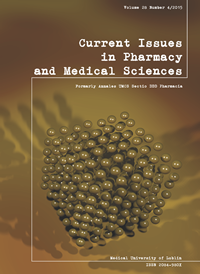The international normalized ratio (INR) as seen in a population of patients with atrial fibrillation and cerebral infarction undergoing long-term treatment with vitamin K antagonists
DOI:
https://doi.org/10.1515/cipms-2015-0087Keywords:
atrial fibrillation, cerebral infarction, international normalized ratio (INR), vitamin K antagonistsAbstract
It is estimated that nearly 20% of all cerebral infarctions in the total population are the result of a complication of atrial fibrillation (AF). While oral anticoagulation with vitamin K antagonists (AVKs) substantially reduces this risk, this requires regular monitoring of the international normalized ratio (INR) in order to achieve therapeutic levels (2,0-3,0). The aim of this study was to evaluate a group at high risk of cerebral infarction, among patients with AF undergoing long-term treatment with VKAs, taking into account the significance of therapeutic INR values. The analysed group consisted of 90 acute ischaemic stroke patients with paroxysmal or chronic “non-valvular” AF, receiving treatment with VKAs. As a result of the study, therapeutic INR values (≥ 2) were seen in thirty-five of these individuals (38,8%), while 55 (61,2%) showed non-therapeutic INR values. Moreover, there were no differences in demographics, vascular risk factors, biochemical and morphological blood parameters, mean CHA2DS2-VASc score and TOAST classification between either of the two groups. Furthermore, no additional factor that would increase their risk of cerebral infarction during the adequate treatment with VKAs was found. However, patients with non-therapeutic INR values had a statistically significantly higher frequency of concomitant moderate pathology of the bicuspid valve, p<0.05. Hence, a lack of proper control of INR can proved to be particularly dangerous for this subgroup of patients. Hence, this is a group with an elevated risk of cerebral infarction and therefore requires special oversight of VKA treatment or NOA treatment.
References
1. Bamford J, at al.: Classif ication and natural history of clinically identifiable subtypes of cerebral infarction. Lancet, 337,1521-1526,1993.
2. Conolly SJ.: Benefit of oral anticoagulant over antiplatelet therapy in atrial fibrillation depends on the quality of international normalized ratio control achieved by centres and countries as measured by time in therapeutic range. Circulation, 118, 2029-2037, 2008. [Web of Science]
3. Crystal E, Connolly SJ: Role of oral anticoagulation in management of atrial fibrillation. Heart 20,813-817, 2004.
4. Garcia DA, Hylek EM.: Antithrombotic therapy in atrial fibrillation. Clin Geriatr Med, 22, 155-156, 2006.
5. Hart RG, at al.: Cardioembolic vs. noncardioembolic strokes in atrial fibrillation: frequency and effect of antithrombotic agents in the stroke prevention in atrial fibrillation studies. Cedrebrovasc Dis, 10, 39-43, 2000.
6. Hart RG, Benavente O, McBride R, Pearce LA: Antithrombotic therapy to prevent stroke in patients with atrial fibrillation: a metaanalysis. Ann Intern Med, 131,492-501, 1999.
7. Hart RG, Halperin JL: Atrial fibrillation and stroke: concepts and controversies. Stroke 32, 803-808 , 2001.
8. Hayek E, Griffin B: Mitral valve prolapse: old beliefs yield to new knowledge. Cleve Clin J Med.69:889-896,2002.
9. Kernan WN, at al.: Guidelines for the prevention of stroke in patients with stroke and transient ischemic attack: a guideline for healthcare professionals from the American Heart Association/American Stroke Association. Stroke, 45, 2160-2236, 2014.
10. Kim YD, at al.: Factors associated with ischemic stroke on therapeutic anticoagulation in patients with nonvalvular atrial fibrillation. Yonsei Med J, 56, 410-417, 2015.
11. Kohsaka S, at al.: Impact of mitral annular calcification on cardiovascular events in a multiethnic community: the Northern Manhattan Study. JACC Cardiovasc Imaging. 1, 617-623, 2008.
12. Lip GY, at al.: Refining clinical risk stratification for predicting stroke and thromboembolism in atrial fibrillation using a novel risk factor-based approach: the EuroHeart Survey on Atrial Fibrillation. Chest, 137, 263-272, 2010.
13. Lip GY, at al.: ABC of atrial fibrillation. Aethiology, pathophysiology and clinical features. BMI 311,1425-1428,1995.
14. Pujol Leris W, at al.: Ischemic stroke in patients with atrial fibrillation receiving oral anticoagulation. J Neurol Sci, 334, 139-142, 2013.
15. Stramba-Badiale M.: Atriall fibrillation subtypes, risk of stroke, and antithrombotic therapy. Eur Heart J 29, 840-842, 2008.
16. Whitlock R, at al.: Antithrombotic and thrombolytic therapy for valvular disease: Antithrombotic Therapy and Prevention of Thrombosis, 9th ed: American College of Chest Physicians Evidence- Based Clinical Practice Guidelines. Chest, 141:576-600, 2012.
Downloads
Published
Issue
Section
License
Copyright (c) 2015 Authors

This work is licensed under a Creative Commons Attribution-NonCommercial-NoDerivatives 3.0 Unported License.


